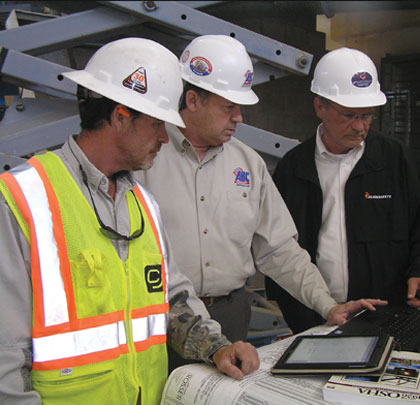One of the critical elements of a leading safety culture is the development and implementation of an effective Injury and Illness Prevention Program (I2P2/IIPP). Of course, many think that IIPP just applies to California, a state that mandated establishment, implementation, and maintenance of an effective IIPP in 1991 for all employers. Another common reference is simply a Company Safety & Health Program.
Regardless of company size, when it comes to safety, health, and environmental compliance, IIPP is a critical resource. Many employers are finding doors closed to opportunity for failing to have an IIPP.
However, creating this documentation is only a small part of the overall process. An effective IIPP is a living, breathing document that must grow with your company, and be maintained and revised accordingly. Beware of feeling secure because you have a written plan. The IIPP talks the talk, but employers must walk the walk. Having documents showing all the critical areas of compliance that your company is committed to and actually doing what those documents state, is crucial. Don’t run the risk of becoming a “policy on paper only” company.
Injury and Illness Prevention Programs vary in size, breadth, and depth; however, they should include the following six areas:
Management leadership. It is essential that all management show and demonstrate their encouragement and support of the IIPP to their employees. Management should provide sufficient information and resources to properly implement their IIPP program. Management should think like a new employee starting on day one and ask themselves what they would want to know about their new employer’s dedication to their health and wellbeing to ensure they get home safely every day.
Worker participation. Management should gain employee feedback during development of the IIPP, and familiarize employees with common workplace safety and health hazards, and subsequent inspections and incident investigations required to share lessons learned.

Hazard identification and assessment. Job Hazard Analysis (JHA) should effectively identify, assess, and document workplace hazards. This is done by continuously communicating with employees for feedback, conducting workplace inspections, and reviewing available data on the hazards of their workplace at the earliest possible stage.
Hazard prevention and control. Employers should create and implement a detailed hazard control plan that will mitigate common health and safety hazards in the workplace. Procurement and distribution of Personal Protective Equipment (PPE) is important, but engineering and work practice controls to eliminate or reduce the hazard itself is always the best course of action, when feasible.
Education and training. Ongoing, effective, and job-specific employee education and training are critical in the success of an IIPP. The given education and training should be written and presented in a way that employees can easily understand and relate to. Employees must be orientated and trained on the recognition, reduction, control, and elimination of potential jobsite hazards. Training should also include the elements and employee participation of the IIPP. Remember, training is not a one and done deal. It must be ongoing to be an effective program. And don’t forget about your subcontractors!
Program evaluation and improvement. Management should organize and conduct a periodic review of the IIPP to insure that it has been implemented correctly and that progressive steps are being taken to achieve the initial proposed goals. Updating of the IIPP is constant and should be ready and available for revision whenever necessary. Some other things to consider:
Self service?
Should employers write an IIPP themselves using a free online IIPP template? Granted, there are many free IIPP templates available online. Do you have the time, expertise, and resources available? Once the document is complete, who in your organization ultimately owns it? Have you established a periodic review and revision process? Remember, if you want peace of mind, leave it to an experienced safety professional. Companies like ClickSafety, have credentialed safety experts on staff who are available to develop, document, and implement required safety and health topics relevant to your company. They offer site visits, on-site auditing, customized training curriculums, and ongoing IIPP updates as necessary.
State mandated?
Currently, 34 states have some type of law, requirement, or incentive for IIPP. Chances are that you operate in one of those states. See this helpful OSHA link: www.osha.gov/dsg/topics/safetyhealth/states
Third-party gatekeepers
ISNetworld and PICS, among others, are valuable resources for hiring companies to prequalify subcontractors, especially those companies who are almost totally reliant on them. Their review and verification processes are very thorough, and supplying policy/procedure documentation, certificates, and other forms of IIPP evidence is routine. Have you already lost the opportunity to bid or perform on a contract because you didn’t have a written Injury and Illness Prevention Program or Safety Plan?
ANSI Z10-2012
The American National Standards Institute’s Z10-2012 Occupational Health and Safety Management Systems, is an excellent consensus standard and blueprint for reference. www.ansi.org
Mandated or not, IIPP is the foundation of an effective safety culture for your company. Employers, ask yourself a question: Am I prepared to defend my safety culture, and what do I have available to assist me in that defense? Does your company even have an Injury and Illness Prevention Program? And if you think you do, you might want to blow the dust off it to see how valid and applicable it is to your current operations. Don’t wait for an incident, accident, or catastrophe to strike only then to learn about the gaps in your safety and health program.
■ ■ ■
[divider]
For More Information Paul J. Colangelo, STS, CHST, CET, currently serves as the national director of compliance programs for ClickSafety. With 22 years of experience, his professional services include developing written injury and illness prevention programs (IIPP), record keeping, site safety inspections and auditing, incident investigation, subcontractor management and training. For more information, contact him at paul.colangelo@clicksafety.com, or call 978.639.3557.
Modern Contractor Solutions, July 2014
Did you enjoy this article?
Subscribe to the FREE Digital Edition of Modern Contractor Solutions Magazine!


